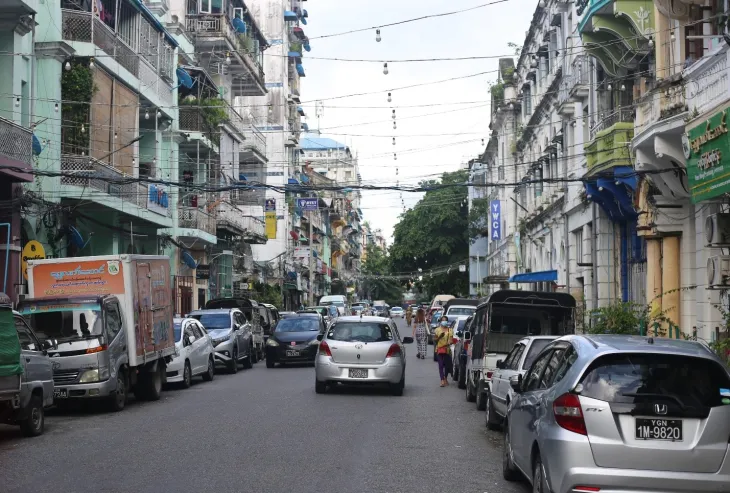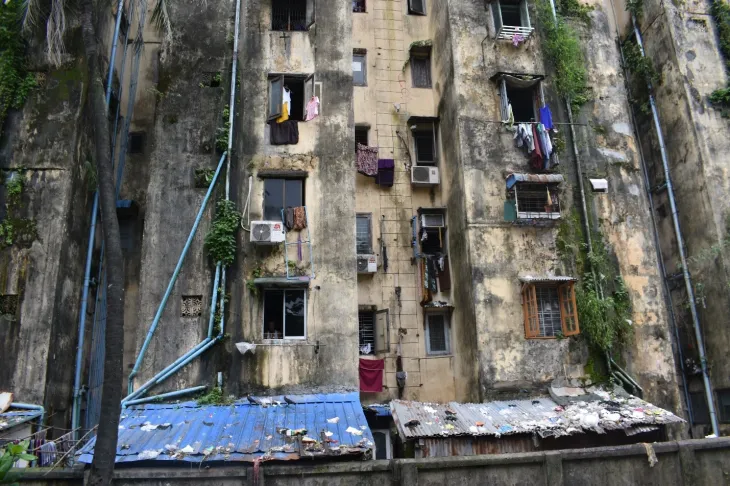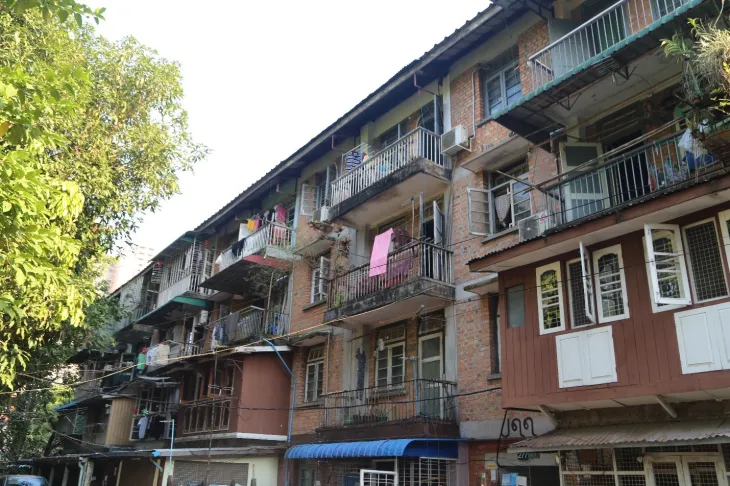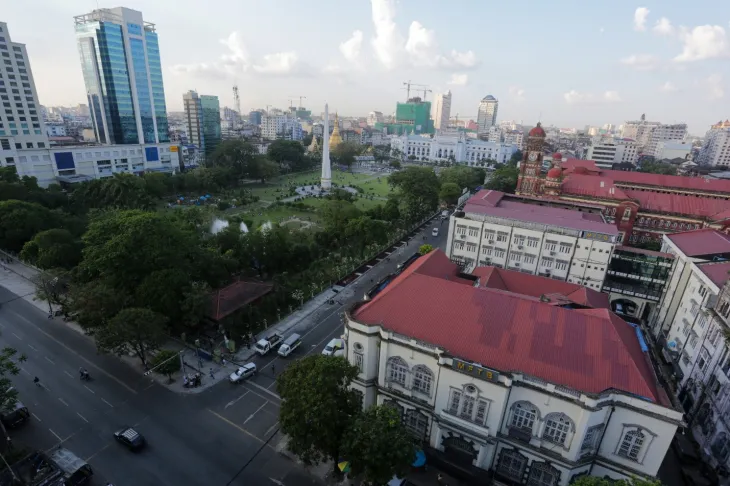Khine Yin Htun explores how social distancing highlights Yangon’s current inadequate housing conditions.
When COVID-19 first hit Myanmar in March, the Yangon Regional Government imposed some control measures by restricting festivals, public gatherings and industrial activities during the Thingyan Water Festival Holidays in Yangon. Few cases of COVID-19 were found in April and it seemed to be under control in June and July. However, the outbreak began again in August with a faster rate of transmission. During the second wave of Coronavirus, some townships with high caseloads, including Hlaing Thar Yar, Shwe Pyi Thar, Thingangyun, Insein, Thaketa, Tamwe, and Dala were put under stay at home orders, though residents could go out of their townships with a QR pass for work, and one person per household was allowed to go to the market and to surrounding neighborhoods.
While the World Health Organization (WHO) is promoting the practice of social distancing and stay-at-home for every country around the world so as to control the virus spread, it is unlikely that a country like Myanmar, where there is a lack of adequate urban housing, particularly in Yangon, can follow these restrictions. Most townships with high caseloads have similar features such as having informal settlements, low-income renters, high density, homelessness, poor housing conditions, and shared living space with the whole family. At the same time, urban poor have struggled when it comes to financial stability, adequate housing, and social issues during the semi-lockdown. Based on the interview from the Myanmar Urban Housing Diagnostic and COVID-19 Rapid Assessment, a 37-year old male, hostel resident and small shopkeeper, from Hlaing Thar Yar said:
“We normal people cannot think about special clothing or living. We can only care about our livelihood and health care. For daily workers like me, the Government’s “Stay Home” order is not really effective and we cannot meet our daily needs. I could only stay at home for 10 days. During those days, we had a small amount of money which we saved for our shop and we used for food. Basically, it was not really enough, so we had to go back to work.”
For instance, a two-story house with five or six family members can likely practice social distancing, while this practice seems impossible for a family with more than 5 family members living in one small apartment in a township like Tamwe. Sadly, the latter scenario will likely be the one that is found throughout most of Yangon. This is particularly damaging given that such living arrangements put the whole family at risk once a single family member contracts the virus.

Yangon’s inadequate housing has been highlighted by the COVID-19 outbreak, even as it has also created pressure on numerous other social issues relevant to people confined in apartments. These include a wide array of negative consequences and side effects such as gender-based violence and domestic abuse, with women and children, especially, targeted in most cases from four corners of the globe. During the lockdown in April and May, the Akhaya Women organization reported a 7.5 fold spike in case reports (mostly of domestic violence) across Myanmar.
Yangon is the largest city in Myanmar, a robust city with the highest economic growth and a population over 5 million. According to the World Bank’s Myanmar Urbanization report, only 25 percent of Yangon households have access to formal housing such as condominiums, apartments, and brick houses, while the remaining 75 percent live in semi-pucca houses (made with some durable materials such as stone, brick or cement) or in temporary structures. It is interesting to observe that only 14 percent of Yangon households can afford housing through the formal housing market, based on data from the National Housing Policy White Paper, written by UN-Habitat in 2018. The high price of land is a key challenge to providing affordable housing in Yangon. Whatever structure or materials are used for a building, if the base land price is too high, the cost for a house is likely to be expensive regardless of the location and size.

During and after the transition to a democratic government following the 2010 elections, most of the government’s land has been leased out with long-term agreements to private investors and business owners investing in western style shopping malls, luxury apartments and hotels across the city. Simultaneously, millions of people from other parts of Myanmar have flooded into Yangon, with some looking for job opportunities and better livelihoods while others fled natural disasters and civil war. However, Yangon does not have enough capacity to accommodate adequate housing for the people who come from other areas. Migrating families with hopes for a better life have instead ended up living in informal settlement areas in peri-urban townships such as Hlaing Thar Yar, Dala, Shwe Pyi Thar, and so on. None of the informal settlements in Yangon has access to basic municipal services including piped water, sanitation facilities connected to a septic tank, municipal drainage and treatment networks, or solid waste management services according to the UN-Habitat assessment.
At the present time, the housing and rental costs in Yangon’s downtown area have sky-rocketed, making downtown space accessible only for upper and middle-class families and higher-earning foreigners. This creates gentrification by pushing working-class people towards peri-urban areas where they need to commute more than one hour with public transportation. This housing inequality has spread towards other townships, for instance to Yankin, which used to be a place full of government housing for working class people. Empty land plots in Yankin have been turned into shopping malls and tall office towers, and residential areas have been replaced by condominiums and high-rise buildings like Golden City and The Central. This redevelopment and increasing housing and rental prices is one of the push factors that cause those who used to live there to move to other areas.

Moreover, construction projects are overflowing in Yankin, where most of the land used to be owned by the government. Most housing in Yankin is in the form of high-rise luxury condominiums and serviced apartments that are targeted to foreign tenants due to the area’s proximity to UN and INGO offices. The built form of the township has also been influenced by wealthy local speculators buying property that they could later sell to foreigners following the 2016 Condominium Law which allows foreigners the right to own some types of condos in Myanmar. Based on observations from the Yankin case, this gentrification creates inequality and causes negative impacts on social cohesion and cultural diversity since all the narratives, memories, and tangible and intangible values of a township are buried by high rise condominiums. This is a big mistake that can be found in most Asian cities, for instance, in Bangkok, Singapore, and Hanoi.

This is occurring not only in Yankin but also in other townships such as Kamaryut and Hlaing which are facing shortages in low-cost rentals for university students who come from other parts of Myanmar. The apartment prices near Yangon University and Inya Lake are very high for the students, even though the condition of the apartment—cheap paint, no windows, and small rooms—is not worth the price charged.
As a consequence of gentrification, families are pushed from the inner city and relocate to satellite townships of Yangon including North Okkalapa, Thaketa, Insein, North Dagon, and Thinganyun. At the same time, newcomers to Yangon can only afford to live in informal settlements due to the sharp rise in inner city housing prices. UN-Habitat identified a total of 423 informal settlements in the city of Yangon and these settlements house an estimated 400,000 people in 72,900 households, or close to 8 percent of the city’s total population. Before the pandemic, Hlaing Thar Yar, Shwe Pyi Thar, Insein, and Dala had a significant number of public health issues associated with diarrhea, dysentery, and malaria due to the lack of clean water and sanitation, which are not provided by the government. In the Myanmar Urban Housing Diagnostic and COVID-19 Rapid Assessment a plumber from Hlaing Thar Yar referred to this: “Nowadays, the drainage hasn’t been dug out recently, so it’s blocked. In the rainy season, the bottom of the house is covered with water. Therefore, we want to improve the drainage system.”
On the other hand, residents of informal settlements have suffered the negative impacts of climate change, including extreme heat waves and floods. But also, the temporary structure housing has increased crime, as there is limited law enforcement in informal settlements. This lack of law enforcement exacerbates social degradation where domestic violence, child abuse, and gender-based discrimination are more likely to occur compared to other townships in Yangon.

In Myanmar, public housing is currently built by the Department of Urban and Housing Development (DUHD) which is a branch of the Ministry of Construction. Myanmar’s public housing provision was established in 1951 and a total of 101,136 housing units have been provided as of 2018. A research paper entitled “Social housing in Myanmar: Issue and way forward” stated that it has been 67 years that rental, low-cost, middle-cost and high-cost housing were provided to citizens across the country, especially in Yangon. However, Yangon’s increasing population has created a high demand for affordable housing, and the government and policy makers still have not met the housing needs. According to the population growth rate, Myanmar is estimated to have 70.56 million population by 2040. Based on the 2014 census, there were 1.5 million units in Yangon, and it is expected to reach 2.65 million housing units in 2040. Thus, Yangon will need about 1 million housing units by 2040.
The “New Yangon” city expansion project was launched by the Yangon Regional Government with New Yangon Development Company in March 2018, to develop the south-western area of Yangon. This area covers approximately twice the size of Singapore with USD$1.5 billion investment for the first phase. The project consists of infrastructure development, land use, economic development, and resilience for this area; however, the project is notorious for a lack of transparency in the planning process. The main focus of the project is to construct low-cost housing and provide job opportunities, yet still there is no information about how they are going to regulate the price for low-income families and deter speculation. Despite having huge housing demands from most of the households in Yangon, the government has failed to meet the needs as the land prices are very high and also most of the current affordable housing locations are way too far from the city center with lack of public transportation and basic infrastructure services.
The Constitution has assigned the management of the housing sector, including urban development, to the states and the regions. Therefore, the regional and local governments are directly responsible for creating an enabling environment for the modernization of the housing sector (ADB-2019). Currently, two major legal initiatives affecting the housing sector are underway, positioned at rather different stages of the legislative process: The Condominium Law and the National Housing Development Law. The Condominium Law was already passed by 2016 at the National Parliament, but some of the mechanisms to implement it are still being created. The draft of the National Housing Development Law (NHDL) has been discussed for a number of years now. Its focus is to provide a regulatory framework for market-based private sector activities according to the National Housing Policy White Paper. The World Bank’s Myanmar Urbanization report pointed out the fact that while recent high level urban policy documents such as the Rapid Urban Diagnostics Report, National Urban Policy Framework, and National Housing Policy White Paper have mentioned the issue of informal settlements, there is no comprehensive informal settlement policy with integrated solutions for the urban poor.
Currently, the Department of Urban and Housing Development (DUHD) is delivering low-cost housing with a long-term mortgage system. However, it has many restrictions. First, a family needs to win the lottery that was set up by DUHD in response to high demand. Second, a family needs to have savings for a 30% down payment at the Construction and Housing Development Bank (CHDB). Third, they need to pay an interest rate of 12-13% for an 8 to 12-year mortgage. This rate is too high for low-income families, and, ultimately, the final payment turns out to be double the original price once they finish the payment term. (Social housing in Myanmar: Issue and way forward 2018).As a 42 year-old construction worker from Hlaing Thar Yar quoted in the Myanmar Urban Housing Diagnostic and COVID-19 Rapid Assessment expressed:“In my opinion, I want to get affordable housing but not for free. The government should set a rate we can afford and we should pay by installments. I think it will work for all.”
Likewise, home loan programs from major banks have a lot of requirements to receive loans with a longer mortgage. This is only targeted towards middle class families, as the interest rate and down payment are both very high. As a 30 year-old factory worker from Hlaing Thar Yar said:
“affordable housing is built everywhere, but the price is not affordable. Only the people who have money can buy the units and we are not capable. If the government will officially build affordable housing for us(people who need it), we will be glad.”

In Myanmar, it is a cultural norm for young people to live with their parents until getting married. This is the biggest social factor that shapes the housing structure in terms of having two bedroom units more commonly available in the market rather than smaller, more affordable one bedroom or studio apartments. For the foreseeable future, developers will build more family-sized housing units as this is a lucrative business for them. Even some married couples have shared the same house with their parents since the rental cost for housing is too high in Yangon. Approximately, 820,000 married couples were not living in their own dwelling unit based on the 2014 census.
As for the youth, living at their parents’ house is a traditional practice which seems to be opposite to that of western countries. Especially for those with stable jobs, moving out of their parents’ home to live either alone or with a partner is considered inappropriate, as Myanmar society is conservative when it comes to couples living together. Moreover, there are a lot of social pressures and discrimination from society when young women choose to live separately, particularly when their parents live in the same city. This cultural norm limits the pressure on authorities to support housing for students and migrant workers, who often need it most. More crucially, from a social security perspective, this housing shortage and Yangon’s high rental cost make it harder for those facing difficulties at home—including domestic violence and sexual abuse—to flee and get their own housing. Noticeably, there is no housing finance mechanism or policy for youth between the ages of 21 to 35 in Myanmar.
COVID-19 is a wake-up call for inclusive housing development in Yangon, with its impact exacerbating both public health and social issues. This is going to be a unique challenge for the newly elected government to solve between 2020 and 2025, as there is not enough accommodation for Yangon’s increasing population. Furthermore, none of the political parties and policy makers raised their voice about housing provision for the urban poor during the 2020 election. Even the ruling National League for Democracy (NLD) party’s 2020 manifesto only mentioned they aim to target economic recovery from COVID-19 by providing support to SMEs. Theoretically, the provision of low-cost housing for poor families can be successful only if the country’s economy is strong; however, economic development won’t be successful unless we have adequate housing and basic infrastructure provision. In addition, it is also a duty of the government to provide adequate and affordable housing that is accessible to its population. The enlargement of informal settlements in Yangon is a direct result of that duty not being met. It is high time for the politicians to recognize housing inequality as a matter of the greatest urgency while overcoming the informal settlement issue and ensuring affordable housing solutions in Yangon.
Khine Yin Htun, is an urbanist and activist, who has been working in the urban development field for over 5 years. She has worked with Doh Eain, SKL International and Habitat for Humanity Myanmar. She is also a current fellow at Urbanize: Policy Institute for Urban and Regional Planning.
Like This Article
June 18, 2024
December 28, 2023
November 22, 2023
April 26, 2023
April 03, 2023

Center for Southeast Asian Studies, Asian Institute 1 Devonshire Place Toronto, Ontario, M5S 3K7, Canada
©TeaCircle All Rights Reserved 2023